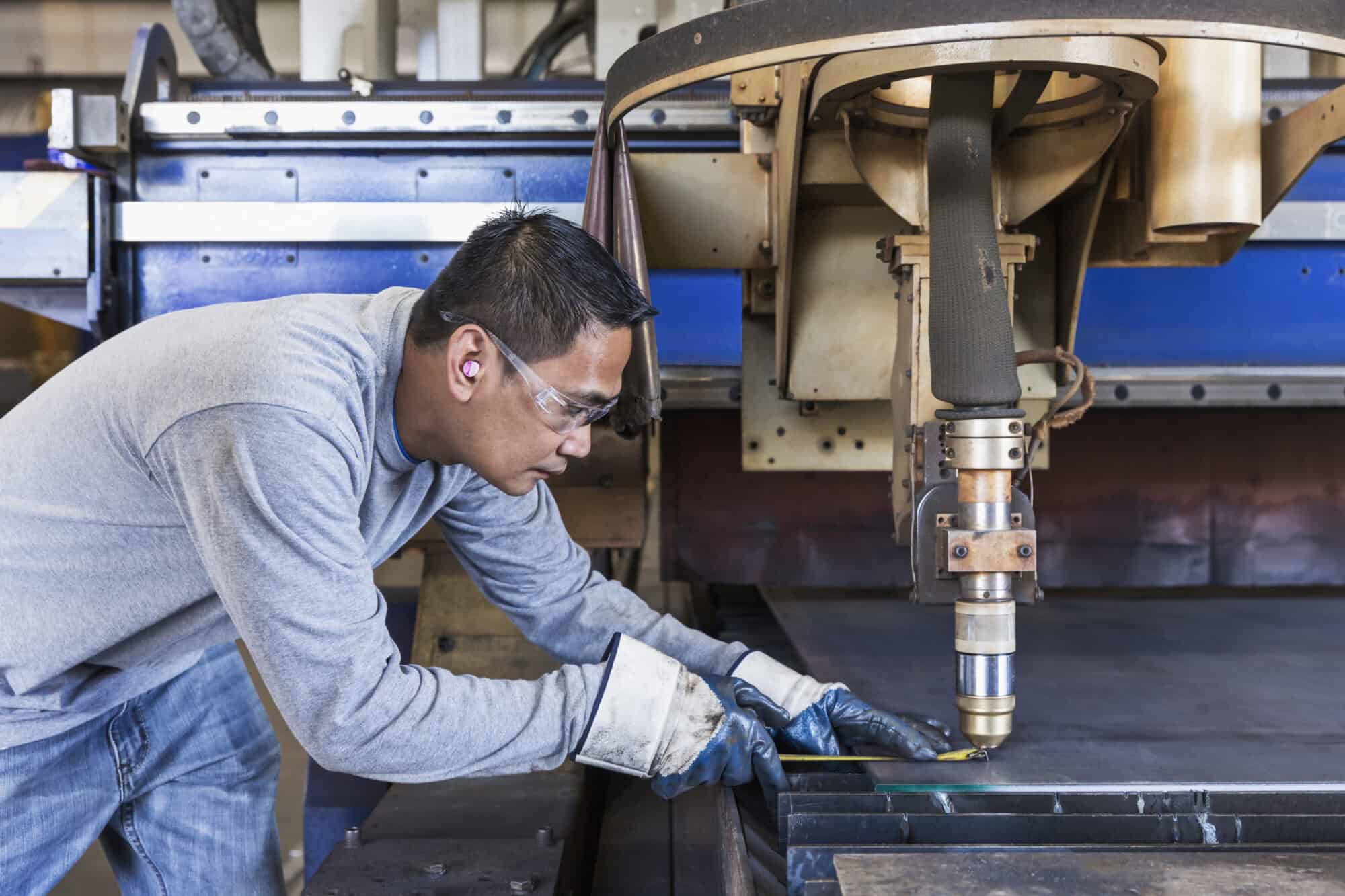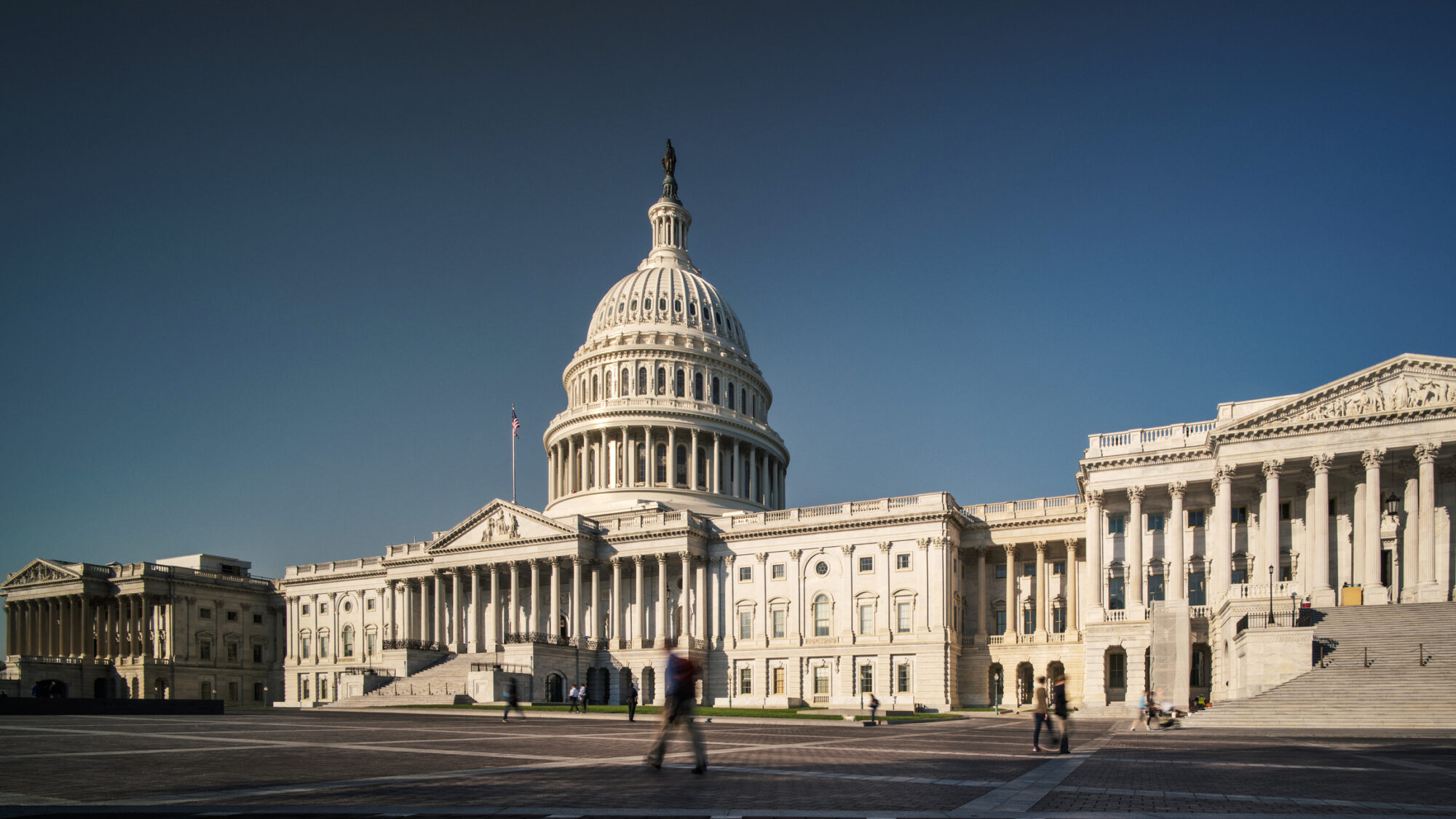Timmons, Chairman Smith: Preserve Tax Reform Now

For a stronger, more competitive America, Congress must make permanent the pro-growth tax provisions from President Trump’s 2017 Tax Cuts and Jobs Act, NAM President and CEO Jay Timmons and House Ways and Means Committee Chairman Jason Smith (R-MO) wrote in a recent op-ed for the Washington Examiner.
What’s going on: “The choice is clear. Congress must deliver the results the American people voted for on Election Day by extending and expanding Trump’s pro-growth tax policies, which have worked so well.”
- The reforms allowed manufacturers “to hire, expand and invest in their communities” at historic rates, with a particularly positive effect on small and medium-sized businesses.
- Georgia-based Winton Machine Company, which produces machinery used in tubular parts and coaxial cable fabrication, would not have been able to expand its workforce, raise employee pay or purchase critical technology had it not been for the TCJA, as Winton CEO and Co-Owner and NAM board member Lisa Winton told Congress in 2023.
- Austin Ramirez, president and CEO of hydraulic and electromechanical control systems maker Husco in Wisconsin and NAM Executive Committee member, told legislators that tax reform allowed his family-owned company “to create jobs, expand research and development, compete globally and invest in its future, including the most significant renovation of his business in 70 years,” Timmons and Chairman Smith wrote.
What’s at stake: “Key provisions of the 2017 Trump tax reforms have already expired, and many more are set to lapse later this year,” Timmons and Chairman Smith continued.
- “Without swift action, manufacturers will miss out on tax incentives for research and development and equipment purchases, while small businesses and family-owned manufacturers will see their tax rate double to as high as 43.4%—all at a time when global competition is intensifying.”
According to a recent NAM study cited in the op-ed, if Congress fails to preserve tax reform by the end of this year:
- Nearly 6 million U.S. jobs—more than 1 million of them in manufacturing—will be lost; and
- America will lose some $1.1 trillion in GDP and $540 billion in wages.
What must be done: Congress must act now to restore the pro-manufacturing tax provisions that have already sunset and make permanent those that are scheduled to expire, Timmons and Chairman Smith concluded.
- “With Trump leading the charge, it is time for Congress to deliver, protect these reforms and set American workers up for success in 2025 and beyond. Together, we can ensure the next chapter in America’s story is one of growth, opportunity and strength.”
Former TSA Communications Lead Joins the NAM

Former Transportation Security Administration Assistant Administrator for Strategic Communications and Public Affairs Alexa Lopez has joined the NAM’s communications team.
What’s going on: Lopez, a native of Dayton, Ohio, is the NAM’s vice president of communications and public affairs, a newly created position.
- “Alexa knows how to navigate complex challenges, craft compelling narratives and drive real impact,” NAM President and CEO Jay Timmons said. “She has built a career on delivering results, and manufacturers will benefit from her ability to elevate our industry’s voice at a time when manufacturers’ influence on the future has never been more important.”
- Lopez holds a Master of Public Affairs and a Master of Arts in Arts Administration from the Indiana University O’Neill School of Public and Environmental Affairs.
Proven track record: At the TSA, Lopez led all media operations, strategic communications, marketing and branding and multimedia efforts and served as adviser to the TSA administrator. She was at the agency for four years.
- Prior to that, Lopez worked in public affairs at the Federal Emergency Management Agency, the American Society of Civil Engineers, Ogilvy Public Relations and the City of Bloomington, Indiana.
NAM Update: President Trump Imposes New Tariffs on Canada, Mexico and China
On Feb. 1, President Donald Trump imposed 25% tariffs on products from Canada with lower 10% on energy products, 25% tariffs on products from Mexico and an additional 10% on products from the People’s Republic of China.
NAM Vice President of International Policy Andrea Durkin and her team break down the actions for manufacturers:
Executive orders impose tariffs on Canada, China and Mexico: On Feb. 1, President Trump, through three separate executive orders, declared a national emergency and invoked the International Emergency Economic Powers Act to apply ad valorem tariffs on products from Canada, Mexico and China, citing the sustained influx of illicit opioids and other drugs.
- Canada Executive Order:“Imposing Duties to Address the Flow of Illicit Drugs Across Our Northern Border”
- China Executive Order: “Imposing Duties to Address the Synthetic Opioid Supply Chain in the People’s Republic of China”
- Mexico Executive Order: “Imposing Duties to Address the Situation at the Southern Border”
How tariffs will apply:
- For products from Canada:
- A 25% tariff will be applied in addition to any already applicable duties, fees or charges.
- A 10% tariff will be applied to “energy or energy resources” defined as crude oil, natural gas, lease condensates, natural gas liquids, refined petroleum products, uranium, coal, biofuels, geothermal heat, hydropower and critical minerals.
- For products from China:
- A 10% tariff will be applied in addition to any already applicable duties, fees or charges.
- For products from Mexico:
- A 25% tariff will be applied in addition to any already applicable duties, fees or charges.
- No duty drawback:No drawback shall be available with respect to the duties imposed pursuant to these orders.
- De minimis: Duty-free de minimis treatment will be suspended.
Timing of the tariffs:
- Tariffs will apply from Feb. 4, 2025.
- Tariffs will not apply to goods loaded onto a vessel or in transit before 12:01 a.m. Feb. 1 with certification to U.S. Customs.
Duration of tariffs: The tariffs will remain in place until the president determines that the governments of Canada, Mexico and/or China have taken “sufficient action to alleviate the crisis,” including through cooperative enforcement actions.
A retaliation clause: The president may increase or expand in scope the tariffs imposed under these executive orders if the governments of Canada, Mexico and/or China impose retaliatory tariffs.
Reports to Congress: The Secretary of Homeland Security, in coordination with the Secretary of the Treasury and other agencies, will submit recurring and final reports to Congress on the state of the national emergency under these orders.
What’s next: The NAM issued a statement in response, and the NAM trade team is analyzing the impact on manufacturers and will continue to engage policymakers on these sweeping trade actions.
Manufacturers on Executive Orders to Impose Tariffs
Washington, D.C. – National Association of Manufacturers President and CEO Jay Timmons released the following statement on the executive orders imposing significant tariffs on imports from Canada, Mexico and China.
“Manufacturers understand the need to deal with any sort of crisis that involves illicit drugs crossing our border, and we hope the three countries can come together quickly to confront this challenge.
“At the same time, protecting manufacturing gains that have come from our strong North American partnership is vital. The success of President Trump’s landmark trade agreement, the United States-Mexico-Canada Agreement, has strengthened North American supply chains and bolstered economic power across the region, boosting jobs, wages and investments here in the United States.
“Thanks to this agreement, one-third of critical U.S. manufacturing inputs now come from Canada or Mexico, rather than from competitors like China that often engage in unfair trade practices.
“However, with essential tax reforms left on the cutting room floor by the last Congress and the Biden administration, manufacturers are already facing mounting cost pressures. A 25% tariff on Canada and Mexico threatens to upend the very supply chains that have made U.S. manufacturing more competitive globally. The ripple effects will be severe, particularly for small and medium-sized manufacturers that lack the flexibility and capital to rapidly find alternative suppliers or absorb skyrocketing energy costs. These businesses—employing millions of American workers—will face significant disruptions. Ultimately, manufacturers will bear the brunt of these tariffs, undermining our ability to sell our products at a competitive price and putting American jobs at risk.
“We stand ready to work with President Trump to ensure a trade strategy that reinforces American strength—holding bad actors accountable while preserving the gains of the successful USMCA and advancing policies that sustain manufacturing growth here at home.”
-NAM-
The National Association of Manufacturers is the largest manufacturing association in the United States, representing small and large manufacturers in every industrial sector and in all 50 states. Manufacturing employs nearly 13 million men and women, contributes $2.93 trillion to the U.S. economy annually and accounts for 53% of private-sector research and development. The NAM is the powerful voice of the manufacturing community and the leading advocate for a policy agenda that helps manufacturers compete in the global economy and create jobs across the United States. For more information about the NAM or to follow us on Twitter and Facebook, please visit www.nam.org.
NAM Names Alexa Lopez as External Advocacy Lead
Portfolio Includes Communications and Public Affairs
Washington, D.C. – The National Association of Manufacturers today announced the addition of former Transportation Security Administration Assistant Administrator for Strategic Communications and Public Affairs Alexa Lopez as the NAM’s vice president of communications and public affairs, a newly created position designed to build on the NAM’s strategic outreach and advocacy efforts.
“Alexa knows how to navigate complex challenges, craft compelling narratives and drive real impact,” said NAM President and CEO Jay Timmons. “She has built a career on delivering results, and manufacturers will benefit from her ability to elevate our industry’s voice at a time when manufacturers’ influence on the future has never been more important. She will be a strong champion for the policies that power innovation, create jobs and keep manufacturing in America strong.”
As NAM vice president of communications and public affairs, Lopez will lead efforts to amplify the voice of manufacturers and advocate for policies that advance the competitiveness of manufacturers in the United States. She will report to NAM Managing Vice President of Communications and Public Affairs Jamie Hennigan.
Previously, Lopez led all strategic communications and public affairs efforts at TSA, serving as principal communications adviser to the TSA administrator on all external and internal communications. She also served in key public affairs roles at the Federal Emergency Management Agency, the American Society of Civil Engineers, Ogilvy Public Relations and the City of Bloomington, Indiana. She holds a Master of Public Affairs and Master of Arts in Arts Administration from the Indiana University O’Neill School of Public and Environmental Affairs. Lopez was proudly born and raised in Dayton, Ohio.
-NAM-
The National Association of Manufacturers is the largest manufacturing association in the United States, representing small and large manufacturers in every industrial sector and in all 50 states. Manufacturing employs nearly 13 million men and women, contributes $2.93 trillion to the U.S. economy annually and accounts for 53% of private-sector research and development. The NAM is the powerful voice of the manufacturing community and the leading advocate for a policy agenda that helps manufacturers compete in the global economy and create jobs across the United States. For more information about the NAM or to follow us on Twitter and Facebook, please visit www.nam.org.
Housing Inventory Drops, Prices Continue to Climb Nationwide
Existing home sales increased 2.2% in December and jumped 9.3% from December 2023, the largest annual gain since June 2021. Housing inventory declined to 1.15 million units, reflecting a 13.5% decrease from November but up 16.2% from last year. The median existing home price was $404,400, up 6.0% from last year, with all four U.S. regions reporting price increases.
Single-family home sales rose 1.9% in December, with the median price increasing 6.1% from December 2023 to $409,300. Condo and co-op sales grew 5.1% in December and 2.5% from the previous year, with the median price up 4.5% from the prior year to $359,000.
Homes were typically on the market for 35 days in December, up from 32 days in November and 29 days in December 2023. First-time buyers made up 31% of sales in December, up slightly from 30% in November and 29% in the same month last year. All-cash sales accounted for 28% of transactions in December, up from 25% in November but down from 29% in December 2023. Meanwhile, investors or second-home buyers represented 16% of homes purchased in December, up from 13% in November and the same as December 2023. Distressed sales, including foreclosures and short sales, represented 2% of purchases in December, unchanged from the past two months and from the previous year.
Optimism Grows, But Tariffs and Strong Dollar Raise Concerns
The S&P Global Flash U.S. Manufacturing PMI rose slightly from 49.4 in December to 50.1 in January, signaling nominal growth in manufacturing after six months of contraction. Both factory production and new orders increased for the first time in six months. Employment also rose for the third month in a row, and the rate of job creation is the highest since July. Supplier delivery times lengthened, indicating busier supply chains, but this was offset by the greatest drop in inventories in 17 months.
The improvement in sentiment was notable in the manufacturing sector, soaring to the highest reading since May 2022, adding to suggestions that activity may improve further in the coming months. Respondents cited a more business-friendly new administration in terms of looser regulation and lower taxes as beneficial to the outlook. On the other hand, others cited concern over tariffs, a strong dollar and higher prices.
Tenth District Manufacturing Activity Contracts Modestly in January
Manufacturing activity contracted modestly in the Tenth District in January, while expectations for future activity remained positive but slipped from 17 to 15 from December. The Tenth Federal Reserve District encompasses the western third of Missouri; all of Kansas, Colorado, Nebraska, Oklahoma and Wyoming; and the northern half of New Mexico. The month-over-month decrease in activity was due to modest declines in both durable and nondurable manufacturing. Most month-over-month indexes were negative, apart from employment, prices and finished goods inventories.
Production fell three points to -9, while new orders improved from -16 to -6. Employment remained roughly the same in January. The backlog of orders remained negative but ticked up to -19 from -22. The year-over-year composite index for factory activity increased from -16 to -9 but stayed negative. Like in December, capital expenditures, prices received and prices for raw materials all increased year-over-year in January while other indexes declined.
This month, survey respondents were asked about their firms’ exports and imports. More than half of firms (55%) sell 1% to 25% of their products or services outside of the U.S., while more than two-thirds (67%) source 1% to 25% of their inputs from outside of the U.S. On the other hand, more than one-third (36%) of firms do not sell their products or services internationally, and only 16% of firms source none of their imports from outside of the U.S. Additionally, a majority of firms do not expect their sourcing decisions to change in the next year (57%) or next three years (53%). Almost a quarter of firms (23%) anticipate slight reductions in internationally sourced inputs in the next three years. Over the next year, 16% of firms forecast increases in sourcing outside of the U.S., while 18% expect increases in the next three years.
The Right Way to Roll Back Regs

Weeks ahead of the inauguration, manufacturers provided the Trump administration with a list of several dozen regulations that should be reconsidered or rescinded to protect manufacturers’ competitiveness. This list covered everything from power plant regulations to employment rules, and some of its recommendations have already been enacted—such as the revocation of the ban on liquefied natural gas exports, which President Trump ordered on Monday.
But signing executive orders is not enough to right-size the regulatory state and remove restrictions on manufacturers’ growth—in general, final agency rules can only be amended through notice-and-comment rulemaking. What does the administration need to do to make this rollback stick?
NAM Chief Legal Officer Linda Kelly spoke to us about the policy and legal landscape that the new administration will have to navigate.
The long term: “Manufacturers need these regulatory changes to withstand the test of time—and legal scrutiny,” said Kelly. Any changes to regulatory policy will be met with legal challenges, which will delay their benefits for manufacturers.
- The new administration needs to do everything by the book and carefully follow recent pronouncements in administrative law, or its policies will not survive, Kelly warned.
- Conducting robust cost-benefit analysis, soliciting public input and tying its actions to congressional mandates will all help the administration make its policies stick, she advised.
The legal hurdles: The big developments overshadowing this round of regulatory reform include the Supreme Court’s Loper Bright decision, which freed courts from deferring to agencies’ interpretations of statutes. Instead, the courts themselves must decide on the “best reading of a statute.”
- When the Trump administration faces judges skeptical of regulatory rollbacks and no longer obligated to defer to agency interpretation, they must come armed with well-reasoned justifications supported by data and informed by the expertise of the regulated public.
- In many cases, the NAM can provide this expertise and crucial data through the rulemaking process, and the NAM Legal Center can help defend pro-manufacturing policies by intervening in litigation and filing amicus briefs.
Agencies in need: Another new requirement for the administration emerged from Ohio v. EPA, which strengthened the requirement that agencies meaningfully respond to objections to proposed rules raised during public comment periods.
- Here again, manufacturers will play a crucial role, said Kelly, offering agencies the evidence they need to support their policymaking.
The last word: “The Trump administration has to do its homework on the front end,” said Kelly, to survive the inevitable legal challenge that will follow its regulatory changes. “Manufacturers and the NAM Legal Center stand ready to help create a court-durable regulatory environment that enables innovation and prosperity.”
NAM: Jerry Jasinowski a Force for Good in Our Nation’s Capital
Industry Honors Legacy of Manufacturing Leader and Visionary
Washington, D.C. – National Association of Manufacturers President and CEO Jay Timmons released the following statement on the passing of Jerry Jasinowski, former NAM president and CEO (1990–2004) and former president of the Manufacturing Institute, the NAM’s 501(c)3 workforce development and education affiliate:
“For decades, Jerry Jasinowski was a force for good in our nation’s capital, a champion for policies that created economic opportunity, a standard-bearer for the industry and an advocate for the manufacturing workforce of America.
“Jerry guided the NAM through some of the most consequential policy debates and economic shifts of the era, shaping the post-Cold War economy. As lawmakers debated history-making agreements like NAFTA and the Trade Promotion Authority Act, they turned to Jerry for expertise and insight. When recession hit in the early 1990s and early 2000s, his steady advocacy helped guide the nation and the industry toward recovery, and his political and media savvy shaped public perceptions of manufacturing. He was a persistent and persuasive voice, not only in the halls of power, but on the air and on America’s editorial pages.
“As Jerry led the industry through a time of transformation, he also transformed the NAM for the better. He elevated the voices of America’s small and medium-sized manufacturers, allowing them to tell their stories directly to members of Congress and giving them a larger role in shaping the direction of the association. Many of America’s small and family-owned manufacturers are the leading voices in today’s most consequential debates on taxes, regulations and more. That, too, is a result of Jerry’s foresight.
“Jerry had the vision to recognize the need to build the manufacturing workforce of tomorrow, and under his leadership, the Manufacturing Institute was created. It became one of his proudest accomplishments and is undoubtedly a cornerstone of his legacy. Today, the MI is the authority on talent in manufacturing, providing recruitment and retention strategies to companies nationwide.
“Through numerous innovative programs, the MI is engaging students as early as middle and high school, recruiting women into manufacturing careers, leading apprenticeship and job training programs, helping veterans transition into the industry and creating opportunities through second-chance programs for individuals reentering the workforce. Its rapid and continued growth and the lives it has changed are a testament to the wisdom of Jerry’s vision.
“From his earlier days as a senior economic adviser to former President Jimmy Carter to his later years as an author and columnist, Jerry spent a career in the spotlight, working alongside and counseling presidents, chief executives and media personalities. But his focus remained steadfast—empowering the people who make things in America and improving livelihoods for all.
“The NAM today mourns the loss of a beloved former leader, whose vision and example we still revere today. We extend our deepest condolences to his wife, Isabel, and to his entire family and all his loved ones, and we make a commitment to celebrate and advance his legacy. After all, his legacy is a stronger, more engaged, more respected manufacturing industry in America.”
-NAM-
The National Association of Manufacturers is the largest manufacturing association in the United States, representing small and large manufacturers in every industrial sector and in all 50 states. Manufacturing employs nearly 13 million men and women, contributes $2.93 trillion to the U.S. economy annually and accounts for 53% of private-sector research and development. The NAM is the powerful voice of the manufacturing community and the leading advocate for a policy agenda that helps manufacturers compete in the global economy and create jobs across the United States. For more information about the NAM or to follow us on Twitter and Facebook, please visit www.nam.org.
